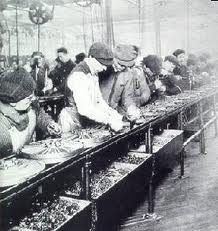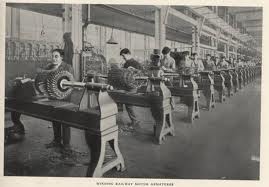At the time that The Principles of Scientific Management was published in 1911, Taylor claimed that more than 50,000 workers were subject to scientific management in the US. The paper was translated into French, German, Dutch, Swedish, Russian, Lettish, Chinese, Hindi, Italian, Spanish and Japanese within two years of publication. However scientific management did not flourish, due to union resistance, until the first World War “when restriction of output and class warfare were considered treasonable” and many non-unionised women were brought into the workforce to replace men away at war.
 Henry Ford, who introduced mass production of cars, adopted Taylor’s methods but took them further with the use of machines to replace some of the tasks performed by workers. Most famous of these was the introduction of a moving conveyor belt in his factories which provided an extension to Taylor’s methods. Instead of workers moving from car to car at their own pace, the belt moved the cars to the workers at a speed set by management, helping to speed up the flow of work and make it difficult for workers to ‘soldier’. In this way Ford removed another element of discretion from workers’ jobs and thereby reduced his reliance on workers’ motivation.
Henry Ford, who introduced mass production of cars, adopted Taylor’s methods but took them further with the use of machines to replace some of the tasks performed by workers. Most famous of these was the introduction of a moving conveyor belt in his factories which provided an extension to Taylor’s methods. Instead of workers moving from car to car at their own pace, the belt moved the cars to the workers at a speed set by management, helping to speed up the flow of work and make it difficult for workers to ‘soldier’. In this way Ford removed another element of discretion from workers’ jobs and thereby reduced his reliance on workers’ motivation.
Ford also broke jobs down into very small parts so that each worker only performed a few movements over and over. As one observer noted of a Ford factory in the 1930s:
Every employee seemed to be restricted to a well-defined jerk, twist, spasm or quiver resulting in a fliver. I never thought it possible that human beings
could be reduced to such perfect automats.
I looked constantly for the wire or belt concealed about their bodies which kept them in motion with such marvelous clock-like precision. I failed to discover how the motive power is transmitted to these people and it don’t seem reasonable that human beings would willingly consent to being simplified into jerks, I assume that their wives wind them up while asleep.
Ford, like Taylor, had a rather low opinion of the worker on his assembly lines: “The average worker, I am sorry to say, wants a job in which he does not have to think. Those who have what might be called the creative type of mind and who thoroughly abhor monotony are apt to imagine that all other minds are similarly restless and therefore to extend quite unwanted sympathy to the labouring man who day in and day out performs almost exactly the same operation.”
Taylor’s innovations together with those of Ford destroyed the tradition of having pride in one’s work for twentieth century factory workers, and absenteeism and high worker turnover was the inevitable response to the unfulfilling boredom of work. During 1913, for example, 50,000 workers left Ford from a total workforce of 13-14,000. So even though it was cheap to train an individual worker, the high turnover rate meant that total training costs were very high.
To overcome this problem Henry Ford experimented with shorter working hours and extra pay and had some success with decreasing the length of the work day from 10 to 9 hours and changing pay and promotion systems. In 1914 he more than doubled the pay of workers to $5 per day. The idea was to motivate the workers and ensure loyalty since this was far more pay than other companies were paying at the time. Absenteeism and turnover dropped, the workers became much more docile and Henry Ford declared that the decision was “one of the finest cost-cutting moves we ever made”.
 To ensure that workers did not use the extra money in a degenerate way, Ford established a ‘Sociological Department’ which consisted of ‘investigators’ who visited workers’ homes “to make sure that no one was drinking too much, that everyone’s sex life was without blemish, that leisure time was profitably spent, that no boarders were taken in, that houses were clean and neat, and so on.” If the investigators were unsatisfied the worker could lose their five dollars a day until he again qualified through “proper living”.
To ensure that workers did not use the extra money in a degenerate way, Ford established a ‘Sociological Department’ which consisted of ‘investigators’ who visited workers’ homes “to make sure that no one was drinking too much, that everyone’s sex life was without blemish, that leisure time was profitably spent, that no boarders were taken in, that houses were clean and neat, and so on.” If the investigators were unsatisfied the worker could lose their five dollars a day until he again qualified through “proper living”.
After the first world war former allies and foes alike sent deputations to the US to learn about scientific management. The Harvard School of Business Administration incorporated it “as a central feature of its curriculum”.
Scientific management was adopted by companies throughout the US, Britain and Europe and even promoted in the Soviet Union by Lenin. It was taken up rapidly in France but adopted more slowly in Britain and Germany where it met with union resistance and some management resistance. However by the end of the 1930s similar management strategies had been widely adopted in most European countries.
Australian employers implemented scientific management increasingly after the first world war and an Australian delegation of employers and unionists, led by enthusiast Prime Minister Stanley Bruce, visited the US in 1926 to learn more about Taylor’s methods.
 In the US Westinghouse Electric became an enthusiastic promoter of scientific management, causing its adoption by other companies it was doing business with including Siemens in Germany and Mitsubishi Electric in Japan. The spread of American multinational firms into other countries also aided the diffusion of scientific management. Ford, for example, set up subsidiaries in Britain, Germany and Japan. Car companies competing with Ford adopted his methods, including Citroën in France, Toyota in Japan and General Motors in the US, Britain, Germany and Japan.
In the US Westinghouse Electric became an enthusiastic promoter of scientific management, causing its adoption by other companies it was doing business with including Siemens in Germany and Mitsubishi Electric in Japan. The spread of American multinational firms into other countries also aided the diffusion of scientific management. Ford, for example, set up subsidiaries in Britain, Germany and Japan. Car companies competing with Ford adopted his methods, including Citroën in France, Toyota in Japan and General Motors in the US, Britain, Germany and Japan.
It was Taylor’s separation of mental and manual labour that became characteristic of mass production methods in the twentieth century. The influence of Taylor and Ford is still evident in many factories today—particularly in mass production in the US and Britain. It is manifest in the job fragmentation, minimal skill and training requirements, maximum repetition, separation of thinking and doing, and the lack of variety in workers’ jobs.
Observers at a Texas Levi Strauss jean factory noted in 1995: “In our tour of the plant, we were struck by the minute segmentation of operations. Six different sewing machine operators, each doing one simple task, were needed to sew a pocket onto the pants. And most operators did the same task, hour after hour, day after day, year after year.”
George Ritzer in his book on The McDonaldization of Society, argued that modern fast food restaurants operate in this way with work being “highly rationalized, geared to discover the most efficient way to grill a hamburger, fry chicken, or serve a meal.” Workers repeat the same simple tasks over and over like robots, have no scope to show initiative or innovation, and utilise a small portion of their capabilities.
Today assembly lines (neo-fordism) and Taylorist methods "have been extended to the service sector in the form of standardized, routinized, regimented, repetitive taks, often requireing of employees ... scripted value-added speech ("Did you find everything you were looking for?" or "would you like a drink with that order?" and the like) that is typical of work routines in retail sales, telemarketing, automobile service, cleriacal jobs, and other low-wage, non-professional occupations, often regimented by Pavlovian automated signaling systems ... that pace the production process". It can even be found in schools where teachers are sometimes expected to follow scripts (see Business-Managed Education - Scripted Teaching)